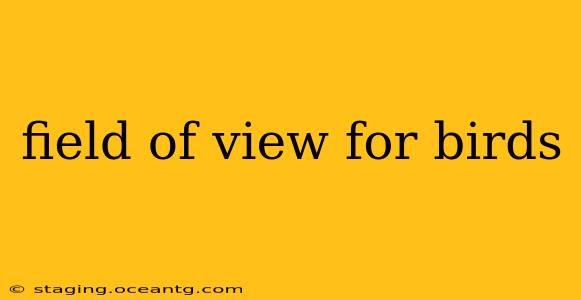Birds are renowned for their exceptional eyesight, playing a crucial role in their survival and diverse behaviors. Understanding their field of view is key to appreciating their remarkable abilities and adaptations. This article delves into the fascinating world of avian vision, exploring the factors influencing their visual capabilities and answering frequently asked questions about bird sight.
What is a Bird's Field of View?
A bird's field of view (FOV) refers to the total area they can see at any given moment without moving their head. Unlike humans, whose FOV is roughly 180 degrees, birds possess vastly different ranges depending on their species and ecological niche. Predatory birds, for example, often have a wider binocular field of view, allowing for precise depth perception crucial for hunting. Conversely, prey birds might have a wider overall field of view, enabling them to detect approaching predators from a greater range of angles. The shape and placement of their eyes significantly influence their FOV.
How Wide is a Bird's Field of Vision?
There's no single answer to this question. The field of view in birds varies dramatically. Some birds, like owls, have a very wide field of vision, particularly horizontally, allowing them to see almost all the way around them without moving their heads. Other birds, like eagles, have a more limited overall field of view but a much larger area of binocular vision, crucial for accurate distance judgment while hunting. Small songbirds often have a wide monocular field of view, allowing them to scan their surroundings for both predators and food sources. The specific FOV depends on a bird's evolutionary adaptations to its specific environment and lifestyle.
Do Birds Have Better Vision Than Humans?
In many aspects, yes. Birds generally possess significantly sharper visual acuity than humans, meaning they can see finer details from a greater distance. Their eyes have a higher density of photoreceptor cells, particularly cones, which are responsible for color vision and sharp detail. This enhanced visual acuity is vital for tasks like spotting prey from afar, navigating during migration, and recognizing mates. However, the extent to which a bird's vision surpasses human vision varies considerably based on species and specific visual tasks.
What is Binocular Vision in Birds?
Binocular vision refers to the overlapping field of view from both eyes, providing depth perception. The degree of binocular overlap varies greatly among bird species. Predatory birds like eagles and hawks typically exhibit a larger area of binocular vision, allowing them to accurately judge distances when hunting. This is crucial for intercepting fast-moving prey. Birds with primarily monocular vision, on the other hand, have less overlap and primarily rely on other cues for depth perception.
How Does the Shape of a Bird's Eye Affect its Field of View?
The placement and shape of a bird's eyes directly influence its FOV. Birds with eyes positioned on the sides of their head (like pigeons) have a wider monocular field of view but a smaller area of binocular overlap. This provides an expansive view of their surroundings, excellent for detecting predators. Birds with forward-facing eyes (like owls) have a more limited overall field of view but a significantly larger area of binocular vision, facilitating precise depth perception vital for hunting in low-light conditions.
Do All Birds See the Same Colors?
While most birds possess excellent color vision, the specific range and perception of colors can vary. Many bird species see a broader range of colors than humans, including ultraviolet (UV) light. This UV sensitivity plays a crucial role in mate selection, as many birds have UV-reflective plumage patterns invisible to the human eye. The ability to perceive UV light also aids in foraging, allowing birds to identify ripe fruits or insects based on their UV reflectance.
Conclusion
The field of view for birds is a complex and fascinating topic, with significant variations across species. Their visual abilities are finely tuned to their ecological niche and lifestyle, reflecting millions of years of evolutionary adaptation. Understanding the nuances of avian vision provides a deeper appreciation for the remarkable capabilities and diversity within the avian world.
